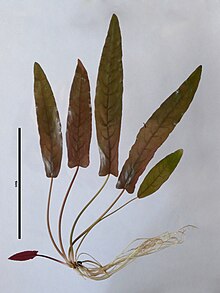Barclaya longifolia
| Barclaya longifolia | |
|---|---|

| |
| Barclaya longifolia in its natural habitat Thailand with emergent chasmogamous flower | |
| Scientific classification | |
| Kingdom: | Plantae |
| Clade: | Tracheophytes |
| Clade: | Angiosperms |
| Order: | Nymphaeales |
| Family: | Nymphaeaceae |
| Genus: | Barclaya |
| Species: | B. longifolia
|
| Binomial name | |
| Barclaya longifolia Wall.[2]
| |
| Synonyms[2] | |
| |
Barclaya longifolia is a species of perennial aquatic plant native to the region of Indo-China to Northwest Peninsular Malaysia.[2]
Description

Vegetative characteristics
Barclaya longifolia is a submerged, perennial, aquatic herb[3] with ovoid, tuberous, stoloniferous, 2-3 cm long, and 0.5-1.5 cm wide rhizomes.[4] The linear-lanceolate, 12-30 cm long and 2-5 cm wide leaves with an obtuse apex, and a cordate base have an undulate margin.[5] The abaxial leaf surface displays red colouration.[3] The petioles are 6-25 cm long.[6]
Generative characteristics
The submerged and cleistogamous, or emerged and chasmogamous,[7] 4-6 cm wide flowers are attached to 5-30 cm long peduncles with numerous trichomes.[4] The sepals are 1.5-2.5 cm long, and 0.5-0.6 cm wide.[6] The syncarpous, inferior gynoecium consists of 8-14 carpels.[8] The globose, reddish green to whitish, 1-2 cm wide fruit bears 1mm long, and 0.5 mm wide, echinate, brownish red, globose seeds[4] without an arillus.[6][8][9]
Cytology
The diploid chromosome count is 2n = 36.[4] The chloroplast genome is 158359 bp long.[10]
Reproduction
Vegetative reproduction
The rhizomes are stoloniferous.[4]
Generative reproduction
Barclaya longifolia can produce autogamous, submerged, cleistogamous flowers,[6][7][4][5] as well as emergent chasmogamous flowers.[7]
Taxonomy
Publication
It was first described by Nathaniel Wallich in 1827.[2] It is the type species of its genus.[6][4]
Type specimen
The type specimen was collected by Wallich in Rangoon, Myanmar in August 1826.[4][6]
Etymology
The specific epithet longifolia, from the Latin longus meaning "long", and folius meaning "leaf", means long-leaved.[11][12]
Conservation
The IUCN conservation status is least concern (LC).[1] It may be endangered in Peninsular Malaysia.[4] In India, it is a rare species.[13]
Ecology
Habitat
It occurs in quickly flowing rivers, streams, and stagnant pools. Disturbance of the substrate by wild boar may be beneficial for the establishment of Barclaya longifolia seedlings in their natural habitat.[4]
Cultivation
It is a popular aquarium plant.[6][5][1] It can be easily cultivated in a mixture of pH-neutral, loamy and mineral soils[4] at temperatures of 26-29°C.[14]
References
- ^ a b c Juffe Bignoli, D. 2011. Barclaya longifolia. The IUCN Red List of Threatened Species 2011: e.T194024A8877322. https://dx.doi.org/10.2305/IUCN.UK.2011-1.RLTS.T194024A8877322.en. Accessed on 04 January 2024.
- ^ a b c d "Barclaya longifolia Wall". Plants of the World Online. Royal Botanic Gardens, Kew. Retrieved 4 January 2024.
- ^ a b Hughes, N. M., & Lev-Yadun, S. (2023). Why do some plants have leaves with red or purple undersides?. Environmental and Experimental Botany, 205, 105126.
- ^ a b c d e f g h i j k Jacobsen, N., Ganapathy, H., Ipor, I., Jensen, K. R., Komala, T., Mangsor, K. N., ... & Ørgaard, M. (2022). "A reassessment of the genus Barclaya (Nymphaeaceae) including three new species." Nordic Journal of Botany, 2022(5), e03392.
- ^ a b c Williamson, P.S., Schneider, E.L. (1994). Floral aspects of Barclaya (Nymphaeaceae): pollination, ontogeny and structure. In: Endress, P.K., Friis, E.M. (eds) Early Evolution of Flowers. Plant Systematics and Evolution Supplement 8, vol 8. Springer, Vienna. https://doi.org/10.1007/978-3-7091-6910-0_9
- ^ a b c d e f g La‐ongsri, W., Trisonthi, C., & Balslev, H. (2009). "A synopsis of Thai Nymphaeaceae." Nordic Journal of Botany, 27(2), 97-114.
- ^ a b c Lok, A. F. S. L., Ang, W. F., Lee, S. M. L., Tan, H. H., & Tan, H. T. W. (2009). "The status and distribution of Barclaya (Nymphaeaceae) in Singapore." Nature in Singapore, 2, 237-245.
- ^ a b Schneider, E. L. (1978). Morphological Studies of the Nymphaeaceae. IX. The Seed of Barclaya longifolia Wall. Botanical Gazette, 139(2), 223–230. http://www.jstor.org/stable/2473739
- ^ "Botanische Jahrbücher für Systematik, Pflanzengeschichte und Pflanzengeographie." p. 224. (1894). Deutschland: Schweizerbart.
- ^ Zhang, H., Si, Y., Zhao, R., Sheng, Q., & Zhu, Z. (2023). Complete chloroplast genome and phylogenetic relationship of Nymphaea nouchali (Nymphaeaceae), a rare species of water lily in China. Gene, 858, 147139.
- ^ Erica longifolia. (n.d.). CasaBio. Retrieved January 4, 2024, from https://casabio.org/taxa/erica-longifolia
- ^ Irons, J. (n.d.). Understanding plant names. Retrieved January 4, 2024, from https://anpsa.org.au/APOL2007/may07-2.html
- ^ "Ecology and Management of Aquatic Vegetation in the Indian Subcontinent." p. 45. (2012). Deutschland: Springer Netherlands.
- ^ Schliewen, U. (2017). "Praxishandbuch Aquarium: Mit über 400 Fischarten, Amphibien und Wirbellosen im Porträt. Der Bestseller jetzt komplett neu überarbeitet." p. 103. Deutschland: GRÄFE UND UNZER Verlag GmbH.
